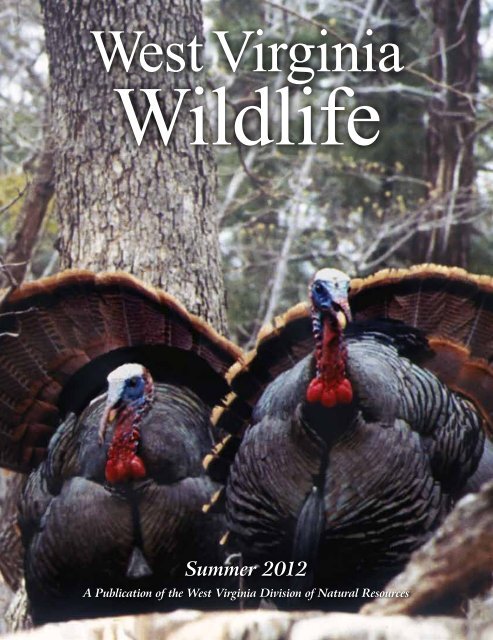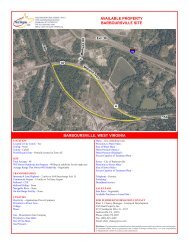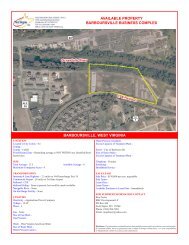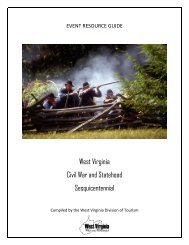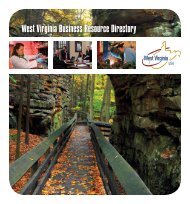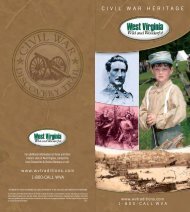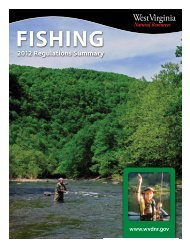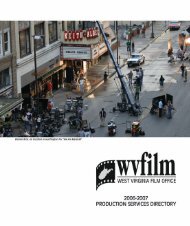Summer 2012 - West Virginia Department of Commerce
Summer 2012 - West Virginia Department of Commerce
Summer 2012 - West Virginia Department of Commerce
- No tags were found...
Create successful ePaper yourself
Turn your PDF publications into a flip-book with our unique Google optimized e-Paper software.
Wild PerspectiveRemembering a LegendAs far back as my high school days in McDowell County,I readily admit to being drawn to anything and everything todo with wild turkeys. During my career as a wildlife biologiststarting at <strong>West</strong> <strong>Virginia</strong> University, then University <strong>of</strong> Tennessee,Tennessee Wildlife Resources Agency and 30 plus years with <strong>West</strong><strong>Virginia</strong> DNR, I have been more than fortunate to spend time withthe legends <strong>of</strong> wild turkey conservation. Glenn “Tink” Smith <strong>of</strong>Piedmont, <strong>West</strong> <strong>Virginia</strong>, was one <strong>of</strong> those legends. While Tinkwas best known for his award-winning, breathtaking photos <strong>of</strong> wildturkeys, perhaps one <strong>of</strong> his best skills was communicating withpeople, and his message was always the same: do whatever we can to promote conservation <strong>of</strong> wildplaces and wildlife, especially turkeys, and introduce our young folks to the wonders <strong>of</strong> nature andthe joy that comes from hunting and fishing.For those <strong>of</strong> you who might not know, Tink’s wild turkey photos were taken from a blindthat started out as a hole in the ground. From this angle, Tink produced images <strong>of</strong> turkeys likeno other – from a chipmunk’s eye view; many times so close he could have touched them. Heliterally took enough pictures <strong>of</strong> wild turkeys, and other wildlife, to fill a good size room, maybe100,000. Instead <strong>of</strong> trying to pr<strong>of</strong>it from his unique talent, Tink would give his photos to anyonepromising to use them to help wild turkey conservation. Tink quickly became a fixture with theNational Wild Turkey Federation and supplied photos for their magazine, which had started outusing pictures <strong>of</strong> tame turkeys because there were very few quality images <strong>of</strong> wild turkeys available.But he also played a monumental role with the newly formed conservation group. He became aspokesperson for the Federation and the need to raise dollars for scientific management <strong>of</strong> hisprecious wild turkey resource, not just in <strong>West</strong> <strong>Virginia</strong>, but across the country. In true<strong>West</strong> <strong>Virginia</strong> fashion, his message was always to the point and down to earth, nothing fancy, just“let’s get the job done.”I saw Tink at every National Wild Turkey Convention I attended and was inspired, humbledand filled with Mountaineer pride every time he took the stage to address the multitude <strong>of</strong>convention goers. It was quickly evident to any in the room that he was a true <strong>West</strong> <strong>Virginia</strong>n,proud <strong>of</strong> his state, his heritage, and what had been done to increase turkey numbers. I alwayslooked forward to my conversations with Tink, no matter what the venue, and I always knew Iwould come away with some <strong>of</strong> his knowledge and skills, whether it was dealing with turkeys orpeople. I was overwhelmed when he took the time to send me a congratulatory card and personalnote when I became Chief with instructions to go out and buy myself a steak dinner!Tink turned 101 years old April 5, <strong>2012</strong>. Sadly, he passed away just 10 days later. He will beremembered and missed by all who were fortunate to hear him speak or be able to spend time withhim. His words <strong>of</strong> encouragement, wisdom and plain old common sense will be forever etched inmy memory. I think about him a lot and carry in my wallet a business-card-sized turkey photo hegave me 20 years ago as a reminder <strong>of</strong> my obligation as a hunter, biologist and <strong>West</strong> <strong>Virginia</strong>n tokeep the welfare <strong>of</strong> the wild turkey foremost in my thoughts and deeds. Tink wouldn’t have it anyother way. Until we meet again, farewell my friend.Curtis I. Taylor, Chief, Wildlife Resources Section
Field TripEdwards Run Wildlife Management AreaKaren McClureDescription: Oak-hickory forest dominates this 387-acre wildlife managementarea. Natural and man-made clearings provide acres <strong>of</strong> edge habitat, andabout 17 acres <strong>of</strong> scrub-shrub make a nice habitat mix for wildlife. The terrainis mostly low, steep-sided hills surrounding the stream that gives the WMA itsname. The campground consists <strong>of</strong> six primitive campsites with pit toilets.A one-acre pond provides anglers the opportunity to fish for stocked trout,along with warm water species including bass, catfish and sunfish.Wildlife Viewing Information: Look for white-tailed deer, squirrels,ruffed grouse and turkeys in the forest and along the forest edges. Thefollowing bird species have all been noted from Edwards Run WMA: turkeyvulture, red-tailed hawk, American kestrel, yellow-billed cuckoo, pileated andhairy woodpeckers, Northern flicker, Eastern wood peewee, Acadian flycatcher,Eastern phoebe, Eastern kingbird, tree swallow, Northern rough-wingedswallow, white-breasted nuthatch, gray catbird, cedar waxwing, red-wingedblackbird and common grackle.Songbirds like the tufted titmouse, yellow-throated vireo, wood thrush,American robin, yellow warbler, song sparrow, indigo bunting, Baltimore oriole,American goldfinch and Louisiana waterthrush can be observed and heard,especially during the spring and summer nesting season.Butterflies abound, most noticeably during midday in the summer. Speciesinclude: falcate orangetip, Eastern tiger swallowtail, spring azure, cabbagewhite, Eastern pine elfin, juniper hairstreak and Juvenal’s duskywing.Edwards Run and the one-acre pond are stocked with trout, and also supportsunfish, bass and catfish. These bodies <strong>of</strong> water can also be good places tospot birds such as Canada geese, mallards and other ducks, and green herons.Visitors can also observe a variety <strong>of</strong> turtles, salamanders and frogs.Green herons may be seen as they stalkfish to eat in Edwards Run and EdwardsRun Pond.Directions: From U.S. Route 50 atCapon Bridge in Hampshire County,turn north on Route 15 and gotwo miles.NOTE: Edwards Run WMA is apublic hunting area. Please checkthe current <strong>West</strong> <strong>Virginia</strong> Huntingand Trapping Regulations or callthe number listed below for huntingseason dates.Ownership: WV Division <strong>of</strong> NaturalResources. 304-822-3551WV Dept. <strong>of</strong> <strong>Commerce</strong>/Steve Shaluta6 <strong>West</strong> <strong>Virginia</strong> Wildlife
PartnersinWildlifeConservation<strong>West</strong> <strong>Virginia</strong> Division <strong>of</strong> Natural Resources’sCooperative Management Partnership withthe U.S. Army Corps <strong>of</strong> Engineers.By Robert A. Silvester8 <strong>West</strong> <strong>Virginia</strong> Wildlife
On Good Friday morning,April 15, 1927, the rainscame, setting all-timerecords over several thousand squaremiles, covering much <strong>of</strong> Missouri,Illinois, Arkansas, Mississippi, Texas andLouisiana. The Memphis CommercialAppeal warned: “The roaring MississippiRiver, bank and levee full fromSt. Louis to New Orleans, is believed tobe on its mightiest rampage. All alongthe Mississippi, considerable fear is felt overthe prospects for the greatest flood in history.” One manrecalled, decades later, “I saw a whole tree just disappear,sucked under by the current, then saw it shoot up, itmust have been a hundred yards downstream. It lookedlike a missile fired by a submarine.”So went the events <strong>of</strong> the great flood <strong>of</strong> 1927,which inundated an area <strong>of</strong> about 26,000 square miles.Levees were breached, and cities, towns and farmslay in waste. The flood waters destroyed crops, andparalyzed industries and transportation. Propertydamage amounted to about $1.5 billion at today’sprices. More than 200 people lost their lives and morethan 600,000 people were displaced.Out <strong>of</strong> this carnage came the Flood Control Act<strong>of</strong> 1928, which committed the federal government toa definite program <strong>of</strong> flood control. Later, the FloodControl Act <strong>of</strong> 1936 authorized the expenditure <strong>of</strong> $310million for flood control projects during the next year.The only limitation on federal flood control projects wasthat the economic benefits had to exceed the costs.Osprey nestlings await the next parental feeding 20 feet aboveStonewall Jackson Lake.Photo by Kirk PiehlerTop: Biologists with the Corps <strong>of</strong> Engineers (left) and theWV DNR Wildlife Resources Section measure thebill <strong>of</strong> a young osprey.Photo by Marshall SnedegarBluestone Dam is one <strong>of</strong> 10 dams in <strong>West</strong> <strong>Virginia</strong> built by the U.S. Army Corps <strong>of</strong>Engineers as a result <strong>of</strong> the Flood Control Act <strong>of</strong> 1936. Completed in 1948,it has been undergoing major renovations the past few years.Since 1936, Congress has authorized the U.S. ArmyCorps <strong>of</strong> Engineers (COE) to construct hundreds <strong>of</strong>miles <strong>of</strong> levees, flood walls and channel improvementsalong with approximately 375 major reservoirs. Aspart <strong>of</strong> this major commitment to flood control forthe Upper Mississippi and Potomac River drainages,the COE has developed and maintains 10 reservoirs in<strong>West</strong> <strong>Virginia</strong>. Tygart Lake, the first impoundment,was completed in 1938. More than 50 years later,Stonewall Jackson Lake, the newest impoundment, wascompleted in 1990.Although flood control is still the primary role<strong>of</strong> these reservoirs, that is not the only major benefitthese reservoirs have had in our state. In addition tothe actual impoundments, more than 124,000 acres <strong>of</strong>land situated around these reservoirs are leased to the<strong>West</strong> <strong>Virginia</strong> Division <strong>of</strong> Natural Resources WildlifeResources Section as wildlife management areas.While many local residents might still harbor some illfeelings over the development <strong>of</strong> these projects on theirfamily farms, many believe the cooperative partnershipbetween the WRS and COE has been a remarkablesuccess story that has benefitted our state’s wildliferesources for more than 50 years.The WRS cooperative partnership with the Corpshas afforded a unique opportunity to develop wildlife<strong>Summer</strong> <strong>2012</strong> 9Courtesy <strong>of</strong> U.S. Army Corps <strong>of</strong> Engineers
More than 18,000 acres comprising Elk River WMA provide publicaccess to land surrounding Sutton Lake. The land also provideshabitat for many wildlife species including the uncommon Easternhognose snake.Photos byWV Dept. <strong>of</strong> <strong>Commerce</strong>/Steve Shalutamanagement programs on Corps projects for numerouswildlife species. Many <strong>of</strong> these areas are composed <strong>of</strong> avariety <strong>of</strong> different forest types. From riparian habitatsand their associated bottomland hardwoods to oakhickoryforest types along the ridge tops, these Corpsprojects provide a mosaic <strong>of</strong> ecological communitiesthat are critical for a variety <strong>of</strong> wildlife species. Almostall <strong>of</strong> the Corps projects are located along majorwaterways where thriving communities and settlementsoccurred. In fact, many <strong>of</strong> these major river bottomswere the focal point for early Indian villages thatpre-date the first European settlements. The Corpsprojects afford protection for these early settlements.With appropriate management practices, these riverbottoms provide invaluable habitat for wildlife species,including cottontail rabbit, bobwhite quail, red-wingedblackbirds, bobolinks and whip-poor-wills.Recently, wildlife biologists have identified morethan 80 species <strong>of</strong> “Greatest Conservation Need”requiring the diverse habitat communities foundon many COE projects. Riparian habitats withbottomland hardwoods interspersed with wetlands,along with herbaceous and shrub cover provideroosting and nesting habitats for wood ducks, andnesting areas for other migratory waterfowl species.Corps areas are frequented by wildlife species suchas bald eagles and ospreys that are listed as species<strong>of</strong> special concern. The uncommon Eastern hognosesnake has been found numerous times on Elk RiverWildlife Management Area around Sutton Lake inBraxton County. According to the most recent surveydata, the range <strong>of</strong> this snake is extremely limited,with only 100 occurrences known statewide.DNR personnel initiated several successfulwildlife management projects on COE projects.Southern <strong>West</strong> <strong>Virginia</strong> counties receivedturkeys trapped on Bluestone Lake WildlifeManagement Area in <strong>Summer</strong>s County10 <strong>West</strong> <strong>Virginia</strong> Wildlife
during the Wild Turkey Restoration Program. Inaddition, wildlife resources personnel trapped andfitted wild turkeys with radio transmitters on severalCOE areas for two studies on wild turkey populationdynamics and gobbler survivability. R.D. Bailey LakeWMA in Wyoming County was the focal point forthe re-establishment <strong>of</strong> deer, turkey and river otter insouthern <strong>West</strong> <strong>Virginia</strong>.The reintroduction <strong>of</strong> osprey in <strong>West</strong> <strong>Virginia</strong>first occurred on Tygart Lake in Taylor County usinga technique call hacking. The term “hacking,” coinedduring the Elizabethan Era, refers to a technique inwhich endangered raptor chicks are placed in boxescontaining nest material perched along high cliffs oratop poles to provide protection from predators. DNRpersonnel place the chicks in these boxes a couple <strong>of</strong>weeks before they fledge. The birds are closely lookedafter and provided with food through a pipe, void <strong>of</strong> anyhuman contact, so they will become independent oncethey are released into the wild. (For more informationon the process, go online to www.wvdnr.gov, click onWV Wildlife Magazine in upper right, click on pastissues and read “Things are Looking Up” in the <strong>Summer</strong>2006 issue.)COE projects located along major waterways suchas the New, Tygart, Monongahela and Ohio rivers arethe main focal point for the WRS migratory waterfowlmanagement programs. These waterways representthe major migration routes through the state. Wildlifemanagement activities include the development <strong>of</strong>various wildlife habitat components that are criticalfor many species. The development and maintenanceDNR wildlifemanager plows fieldat Bluestone LakeWMA in preparationto plant food andcover for wildlife.Photo by Colin CarpenterCrabapple with protective exclosure to prevent over-browsing by deer.<strong>of</strong> openings with herbaceous plants by mowing, limingand fertilizing have established critical brood rearinghabitat for turkey, ruffed grouse and many grasslandbird species. Roads and trails are sometimes gated andmaintained as linear wildlife openings. Gated roadsprovide a refuge with limited disturbance for wildlifespecies to raise their <strong>of</strong>fspring. Planting a variety <strong>of</strong>fruit and nut-producing shrubs and trees, coupled withthe pruning <strong>of</strong> existing fruit trees, ensures an amplesupply <strong>of</strong> s<strong>of</strong>t and hard mast foods for wildlife.Existing fruit trees require sunlight, so clearingcompeting vegetation allows more light to reach thetrees. Planting annual grasses and grain crops providesforaging areas for several wildlife species. The control<strong>of</strong> noxious vegetation with herbicides provides betterforaging areas for wildlife species and limits the spread<strong>of</strong> these invasive plant species that compete againstnative plants which provide optimal food and coverfor native wildlife. The development <strong>of</strong> marshes alongriparian areas that are periodically flooded providescritical habitat for waterfowl species.Colin Carpenter<strong>Summer</strong> <strong>2012</strong> 11
A timber harvest on Bluestone WMA creates an opening whichbenefits wildlife.Prescribed burns improve habitat for many wildlife species.Planned timber harvests are a vital habitatmanagement tool benefitting numerous forest wildlifespecies. Early successional forest habitat (five to 20years after cutting) is critical for many wildlife species<strong>of</strong> concern. The American woodcock, ruffed grouse,rufous-sided towhee and golden-winged warblerthrive in these communities and are examples <strong>of</strong>species in decline. Stonewall Jackson Lake andGreen Bottom Wildlife Management Areas wereselected for the development <strong>of</strong> American WoodcockDemonstration Areas which showcase the BestManagement Practices (BMP) for developing woodcockhabitat. This project is part <strong>of</strong> the AppalachianWoodcock Initiative and one <strong>of</strong> the goals outlined bythe North American Woodcock Conservation Plan.Colin CarpenterColin CarpenterMaintaining oak forests is also vital in developingsound wildlife management programs. Usingshelterwood cuts, where approximately 50-60 percent<strong>of</strong> the forest overstory trees are removed, allowsfor a new generation <strong>of</strong> oak seedlings to perpetuateoak forests. Monies generated from timber salesare invested in the same areas to fund additionalmanagement programs. In addition to timber harvests,wildlife managers have incorporated prescribedburning, a technique where fire is used during properweather conditions to remove competing vegetationwhile also releasing important nutrients back into thesoils to help the desired species <strong>of</strong> plants grow in thenewly regenerated stands.In addition to the upland wildlife programs,WRS fisheries personnel actively manages the fisheriesresources in Corps reservoirs and large river systemssuch as the Ohio and Monongahela rivers. Fish habitatenhancement projects include the development<strong>of</strong> aquatic vegetation to improve spawning andnursery areas, and placement <strong>of</strong> fish attractors suchas Christmas trees collected by the <strong>West</strong> <strong>Virginia</strong>Division <strong>of</strong> Environmental Protection RehabilitationEnvironmental Action Plan (REAP) program. Theseattractors are placed near the shore line to accommodateboth boating and shore line anglers. Other artificialstructures that attract fish include concrete block andplastic pipe “spider blocks.” They are so named becausethey resemble a giant spider when completed. Spawningenhancers such as catfish spawning boxes and clean peagravel are put in some COE lakes. The establishment <strong>of</strong>these habitat projects involves several groups includingCorps staff and volunteers from the <strong>West</strong> <strong>Virginia</strong>Bass Federation and Muskies Inc.The value <strong>of</strong> these Corps projects for fish andwildlife habitat is apparent. Their importanceEmergent vegetation beds planted by DNR personnel providecover for young fish and other aquatic animals.12 <strong>West</strong> <strong>Virginia</strong> Wildlife
Wildlife Resources Sectionpersonnel tie discardedChristmas trees to cinder blocksand place them in the bottom <strong>of</strong>reservoirs during winter drawdownto provide shelter for fish.Photo by Jim Walkeras public access areas for hunting, fishing and otherwildlife-associated recreation is particularly valuable,as opportunities to pursue these activities declineon privately-owned lands. As the demand to developadditional recreational facilities such as cabins,campgrounds, golf courses and ball fields on COEland increases, we need to understand how vitalundeveloped areas are to our state’s wildlife andJim Walkercitizens. Urban sprawl and other human activity hasfostered increased habitat fragmentation and loss,decreased water quality, and an alarming increase inwildlife-human conflicts that may eventually leadto more declines in wildlife numbers. This humanencroachment on wildlife communities has created anuncertain future for many wildlife species. In an erawhen the demand for public access areas for hunting,fishing and other wildlife-associated recreationalopportunities is at an all-time high, and is projectedto increase with each passing year, these COE landsare essential to the well-being <strong>of</strong> <strong>West</strong> <strong>Virginia</strong>’swildlife resources.Robert A. Silvester is the District Wildlife Biologist stationed atFrench Creek.<strong>Summer</strong> <strong>2012</strong> 13
<strong>West</strong> <strong>Virginia</strong>’sCelebration <strong>of</strong>By Jerry <strong>West</strong>falland Art ShomoIts History and PurposeEvery year, on the fourth full weekend inSeptember, something special happens. Allacross the country, Americans come togetherto celebrate their love <strong>of</strong> hunting and fishing. So younever heard about this exciting event? It’s called NationalHunting and Fishing Day, and is sponsored by many statewildlife agencies all over the United States. <strong>West</strong> <strong>Virginia</strong>is no exception, as the state will celebrate its 35th annualNational Hunting and Fishing Day (NH&FD) Celebrationon September 22-23, <strong>2012</strong>. This event is jointly sponsoredby the <strong>West</strong> <strong>Virginia</strong> Division <strong>of</strong> Natural Resources andthe <strong>West</strong> <strong>Virginia</strong> Wildlife Federation.The history <strong>of</strong> the NH&FD movement takes usback to the 1960s, when hunters and anglers wereinterested in the ideas promoted by the growingenvironmental movement. They understood longbefore the 1960s that wildlife is intricately associatedwith habitat, and that habitat destruction ordegradation negatively affected wildlife. They weredismayed, however, that the contributions hunters andanglers made to habitat protection and enhancementwere not being communicated to the public. Somepeople did not understand the critical role hunters andanglers play in conservation.14 <strong>West</strong> <strong>Virginia</strong> Wildlife
Left to Right: Shooting air rifles at the 1978 celebration at French Creek. Crowd at Stonewall Resort State Park watches the headline event.The late Rev. Stacy Groscup demonstrates the use <strong>of</strong> a blow gun. Master longbow archer Byron Ferguson performs a trick shot.DNR photosThe first suggestion for a day recognizing theconservation role played by hunters and anglersoriginated in Pennsylvania. Ira J<strong>of</strong>fe, owner <strong>of</strong> J<strong>of</strong>fe’sGun Shop in Upper Darby, Pennsylvania, broughtthis idea to state <strong>of</strong>ficials. In 1970, PennsylvaniaGovernor Raymond Shafer, liked the idea so wellthat he created “Outdoor Sportsman’s Day” in thestate. With prompting from the National ShootingSports Foundation, the success and popularity <strong>of</strong> thiscelebration soon came to the floor <strong>of</strong> the U.S. Senate.In June 1971, Thomas McIntyre, a U.S. Senator fromNew Hampshire, introduced Joint Resolution 117authorizing National Hunting and Fishing Day on thefourth Saturday <strong>of</strong> every September. An identical billwas introduced in the U.S. House <strong>of</strong> Representatives byFlorida Rep. Bob Sikes. Congress unanimously passedboth bills in early 1972.On May 2, 1972, President Richard M. Nixonsigned the National Hunting and Fishing Day Bill. Onthe day <strong>of</strong> signing he wrote, “I urge all citizens to joinwith outdoor sportsmen in the wise use <strong>of</strong> our naturalresources and in insuring their proper managementfor the benefit <strong>of</strong> future generations.” The adoption<strong>of</strong> a NH&FD Celebration soon blossomed across thecountry. NH&FD was quickly adopted by 50 governorsand more than 600 mayors across the country. Thefirst events were held in 1973. It is estimated thatapproximately 3,000 “open house” celebrations <strong>of</strong>National Hunting & Fishing Day occurred in thoseearly years. These celebrations were held in places suchas shooting ranges and suburban frog ponds. In 1975,President Gerald Ford mandated that NH&FD be heldthe fourth Saturday in September, and it has stayedthat way ever since.Over the years, most state celebrations <strong>of</strong> NH&FDhave been refined to single large annual events. Anational umbrella organization, NH&FD Program,provides a clearinghouse <strong>of</strong> information and steers thenationwide celebration. National honorary chairs <strong>of</strong>NH&FD have included President George Bush, TerryBradshaw, Hank Williams Jr., Tom Seaver, ArnoldPalmer and Jeff Foxworthy, among many others.<strong>Summer</strong> <strong>2012</strong> 15
National Hunting and Fishing Days1978: French Creek, <strong>West</strong> <strong>Virginia</strong>The idea <strong>of</strong> holding a big celebration <strong>of</strong> NationalHunting and Fishing Day in <strong>West</strong> <strong>Virginia</strong> at theState Wildlife Center was the brainchild <strong>of</strong> BillVanscoy, former superintendent <strong>of</strong> the French CreekGame Farm, as it was called at the time. Early in1978, he tasked Art Shomo, who operated the mobilewildlife exhibit, with organizing the event. The firstDNR celebration <strong>of</strong> National Hunting and Fishing Daywas held September 22-24, 1978 at the wildlife facilitylocated 12 miles south <strong>of</strong> Buckhannon.The event included displays <strong>of</strong> recreational vehicles,boats, and hunting, fishing and trapping equipment.Visitors could watch demonstrations <strong>of</strong> electro-fishing,turkey cannon netting, fly casting and bird dogtraining. Attendees could try their hand at shootingmuzzleloaders, air rifles and shotguns. Contestsincluded a raccoon hunt, raccoon dog bench show andturkey calling. In addition, wildlife movies were shownin a large tent supplied by the National Guard. Morethan 5,000 visitors attended that year. The celebrationcontinued at French Creek until 1996 when it wasmoved to Stonewall Jackson Lake Resort State Park foreasier access and more space.Today, <strong>West</strong> <strong>Virginia</strong>’s NH&FD Celebrationcontinues to grow in popularity. Stonewall ResortState Park is an ideal location for the event because itis located close to the state’s center and is just minutes<strong>of</strong>f Exit 91 <strong>of</strong> Interstate 79. <strong>West</strong> <strong>Virginia</strong>’s event willlikely be held at the park in the foreseeable future.Recent headline acts and seminars continueto generate buzz about <strong>West</strong> <strong>Virginia</strong>’s NH&FDCelebration. Internationally acclaimed longbow trickshooter Byron Ferguson is the event’s highlight andlargest draw. Byron shoots instinctually and can split aplaying card in half from the side, shoot dimes out <strong>of</strong>the air, and snuff out candles with an arrow. Byron’sperformances always draw large crowds. Tom Bechdelhas annually brought his nationally acclaimed seminar16 <strong>West</strong> <strong>Virginia</strong> Wildlife
For <strong>West</strong> <strong>Virginia</strong>’s first National Hunting and Fishing Day Celebration,army tents became a movie theater.Retriever demonstration at the 1978 celebration.DNR photoson eastern coyote hunting. Other seminars andand clay pigeon shooting. Other shooting opportunitiesdemonstrations focus on hunting safety, fishing, snakes are available with air rifles and crossbows.and birds <strong>of</strong> prey.Children learning hunting and fishing techniquesBut perhaps the greatest thing about <strong>West</strong> <strong>Virginia</strong>’s – and having fun doing it – makes the NationalNational Hunting & Fishing Day Celebration is the Hunting & Fishing Day Celebration very special.ability for both adults and children to see wildlife skills Activities for youth include archery instruction,demonstrated and to participate in outdoor skills.3-D archery shooting and a hunting simulator withPopular demonstrations include the deer and squirrel laser guns, as well as the opportunity to shootfield dressing and skinning – passing on the declining a muzzleloader, .22 rifle, shotgun, and air rifle.knowledge <strong>of</strong> these necessarytechniques. The wild game andfish cooking demonstration,providing free samples <strong>of</strong>popular recipes, is always a bighit. In addition, the public cantry their hand at fly fishingand learn the art <strong>of</strong> controllingbird dogs. On the shootingrange, the public can try (at noadditional cost) muzzleloadershooting, .22 rifle shooting, Cutting edge film technology circa 1978.DNR photoShooting opportunitiesthat are provided at noadditional cost are closelysupervised. Popular exhibitsthat always bring the publicback include a big buckdisplay, trophy fish display,and animal track display.The Outdoor YouthChallenge has evolved fromstrictly a competition formatto an outdoor skills and<strong>Summer</strong> <strong>2012</strong> 17
Bill Vanscoy demonstrates deer field dressing.DNR Director Frank Jezioro and Stoney ready for action.DNR photosknowledge event in which youth ages 6-18 can eithercompete in a set <strong>of</strong> activities or just participate inany <strong>of</strong> the activities <strong>of</strong>fered. Any youth participatingin the challenge is eligible to win prizes, includinglifetime hunting and fishing licenses! The winners <strong>of</strong>the competition format receive scholarships to summerconservation camps in <strong>West</strong> <strong>Virginia</strong>.Visitors can peruse tables <strong>of</strong> outdoor-relatedequipment set up by numerous vendors. They can alsosatisfy their appetite by visiting food booths set up byboth commercial businesses and non-pr<strong>of</strong>it organizations.So, why do the DNR and the <strong>West</strong> <strong>Virginia</strong>Federation co-sponsor the National Hunting andFishing Day Celebration every year? Certainly, <strong>West</strong><strong>Virginia</strong>’s event shares the initial reason for thenational celebration: to showcase the accomplishmentsand continued benefit hunters and anglers play inconservation. But <strong>West</strong> <strong>Virginia</strong>’s Celebration is designedto generate excitement about outdoor-related activitiesand ultimately promote recruitment and retention foryoung, budding hunters, anglers and wildlife-watchers,and for those older individuals who have temporarilyabandoned these sports. With this event, the DNR hopesto help preserve <strong>West</strong> <strong>Virginia</strong>’s outdoor heritage. Wehope to educate the public by providing opportunitiesto learn the skills, safety, ethics, respect and stewardshipneeded for these outdoor activities. And basically, justto encourage folks to get outdoors. The Celebration alsoprovides an outstanding outreach opportunity, allowingthe public to learn about DNR’s management activitiesand wildlife law enforcement. In addition, it providesfolks an opportunity to learn how other organizations,agencies, landowners and businesses help to conserve<strong>West</strong> <strong>Virginia</strong>’s wildlife and preserve our hunting andfishing heritage.So, if you haven’t checked out <strong>West</strong> <strong>Virginia</strong>’sNH&FD Celebration, do yourself, and your family,a favor and come out this year to see what all theexcitement is about. You’ll soon understand why many<strong>West</strong> <strong>Virginia</strong>ns come back to the event year after year.Jerry <strong>West</strong>fall is the Assistant District Wildlife Biologist stationedin Parkersburg.18 <strong>West</strong> <strong>Virginia</strong> Wildlife
WV Dept. <strong>of</strong> <strong>Commerce</strong>/David Fattalehvs. Birds!BackgroundYou have heard it before – birds are real lightweights.See if you can stack up to the physical feats <strong>of</strong> ourfeathered friends. This activity allows people to see if theycan run faster and jump higher, so to speak, than somerecord-breaking birds. This is a great way to learn more aboutbirds, and get a little exercise.ObjectiveCompetitors use math to compare their own adaptations andabilities to those <strong>of</strong> some birds. This activity is a sneaky wayto use science, environmental education, social studies, math,and physical education into a fun activity.MethodContestants follow the event instructions to measuretheir abilities, and compare them to the informationon birds provided.Materials• A flat area 25-30 yards long• Paper• Pencil• Tape measure• Stopwatch• Flagging or rope to mark <strong>of</strong>f 20 yards• Small container to hold something fragrant• Scented items (orange peel, cologne, flavoring extract, etc.)• CalculatorWhat to doIf the competitors are working as a team <strong>of</strong> two, then havethem take turns following the directions at each station andcompare themselves to the birds. For a larger group, set upeach station in a different area, and divide the group in two,half as station leaders, and the other half as contestants.The contestants move through the stations, with at leastone leader at each station. After the contestant groups goesaround to all <strong>of</strong> the stations, switch jobs so the leaders can gothrough, and the contestants can be the leaders.The activity was reprinted with permission from Flying WILD@2010, Council for Environmental Education.WV Dept. <strong>of</strong> <strong>Commerce</strong>/Steve ShalutaWV Dept. <strong>of</strong> <strong>Commerce</strong>/Steve Shaluta<strong>Summer</strong> <strong>2012</strong> 19
20 <strong>West</strong> <strong>Virginia</strong> Wildlife
<strong>Summer</strong> <strong>2012</strong> 21
22 <strong>West</strong> <strong>Virginia</strong> Wildlife
<strong>Summer</strong> <strong>2012</strong> 23
Wild AlmanacBrook TroutAccessRestored onShavers ForkTributaryThe DNR and its partners have completed amajor project to restore spawning access forbrook trout in Beaver Creek <strong>of</strong> the ShaversFork River above Cheat Bridge in RandolphCounty. “For the first time in 25 years, brooktrout in the Shavers Fork main stem canmove upstream into Beaver Creek to theircritical tributary spawning areas,” DNRDirector Frank Jezioro said.Besides improving brood trout habitat and access to their spawning areas,the project doubled the flood capacity <strong>of</strong> the Beaver Creek culverts.Steve BrownUnique in <strong>West</strong> <strong>Virginia</strong>, Shavers Fork is a high-elevation, big-river brook troutfishery. For more than a century, the river and its watershed have been impacted byactivities such as logging and railroad construction which have reduced brook trouthabitat and populations. Recent plans to restore brook trout have prioritized bothhabitat restoration and removal <strong>of</strong> fish passage barriers between the main stem andthe species’ spawning tributaries.The DNR Wildlife Resources Section has expanded its successful Acid StreamRestoration Program to include physical habitat restoration as well as stream liming.Director Jezioro said, “New grant funding for stream restoration became available tous through congressional appropriations and the Eastern Brook Trout Joint Venture.”To build the Beaver Creek project, biologists worked with key partners at <strong>West</strong> <strong>Virginia</strong>University’s Natural Resources Analysis Center and others, assembling a team <strong>of</strong>experts with unique expertise and skills. The team included DNR biologists, WVUresearch scientists, stream restoration experts from Canaan Valley Institute, and railroadconstruction specialists from TrakSpec Railroad Corporation, based in Hurricane, W.Va.Because the project site is located on a remote section <strong>of</strong> railroad, all constructionmaterial such as logs and rocks and heavy equipment had to be transported to the siteby rail. TrakSpec’s expertise and equipment was critical.In the end, the team built a new, fish-friendly section <strong>of</strong> stream with a sophisticatedcomplex <strong>of</strong> culverts, the centerpiece <strong>of</strong> which is a partially-buried 10-foot culvertcontaining a simulated stream channel.Midway through the project, a major design change was required to meet amandatory construction deadline and to provide a design that could be more readilyused for additional streams. “The most impressive thing for me was the way the teampivoted to an entirely new design and pulled together to build such a high-qualityproject,” DNR Program Manager Steve Brown said. He added, “Major thanks go tothe guys at CONTECH Construction Products who located a 10-foot culvert for usin a matter <strong>of</strong> hours and had it on site in three days. I also want to thank State RailDirector Cindy Butler and the State Rail Authority.Looking to the future, Director Jezioro observed that the project is a good model forfuture transportation culvert replacements because it complies with all current andproposed Corps <strong>of</strong> Engineers requirements for fish passage through culverts.Briery Mountain WMAin Preston CountyPermanently ClosedEffective Oct. 31, 2011, the leasebetween the <strong>West</strong> <strong>Virginia</strong> ArmyNational Guard and the <strong>West</strong> <strong>Virginia</strong>Division <strong>of</strong> Natural Resources for theBriery Mountain Wildlife ManagementArea was terminated, and the area willbe closed to public use.“The removal <strong>of</strong> Briery Mountainas a WMA is necessary because <strong>of</strong>anticipated increase in training activity bythe <strong>West</strong> <strong>Virginia</strong> Army National Guard,which will restrict public access to thearea,” said Curtis I. Taylor, Chief <strong>of</strong> theDNR Wildlife Resources Section. “Thesetraining activities will create public safetyconcerns that are not compatible with theuse <strong>of</strong> the area as a WMA.”Public lands in the Preston Countyregion that are available to hunters,trappers and anglers include theCoopers Rock State Forest, and theSnake Hill and Blackwater WMAs.Information on these public lands isavailable from the District 1 DNR Officein Farmington (304-825-6787), the 2011-<strong>2012</strong> Hunting and Trapping RegulationsSummary, and from the DNR website atwww.wvdnr.gov.24 <strong>West</strong> <strong>Virginia</strong> Wildlife
Wild AlmanacReporting fish and wildlifeviolations in <strong>West</strong> <strong>Virginia</strong>just got easierThe Law Enforcement Section <strong>of</strong> the <strong>West</strong> <strong>Virginia</strong> Division <strong>of</strong> Natural Resourceshas added a new website option for reporting activity that threatens fish and wildlife.Submitting a tip sends a message to DNR district <strong>of</strong>fice staff for response. Thewebsite can be found at www.wvdnr.gov/LEnforce/Poachers.shtm."We have a limited number <strong>of</strong> Natural Resources Police Officers in the field, sothe public plays a critical role in protecting our natural resources by reportingviolations," said Lt. Col. Jerry Jenkins <strong>of</strong> the DNR Law Enforcement Section."Submitting a report is a quick and easy way to report violations.”Subscribe to<strong>West</strong> <strong>Virginia</strong> WildlifeIf you would like a free subscription delivered to your mailbox or to send a subscriptionto someone else, please complete this form and you will be added to the mailing list.(One subscription per household please.)Mail completed form to:WV Wildlife MagazineElkins Operations CenterP.O. Box 67 • Elkins, WV 26241DNR law enforcement <strong>of</strong>ficers askanyone who witnesses a potentialviolation to collect as muchinformation as possible withoutconfronting the individual undersuspicion. Jenkins said helpfulinformation includes license platenumbers, vehicle color and make,the type <strong>of</strong> violation, the time itoccurred and a description <strong>of</strong> theindividual or individuals involved.“Reporting a crime with this formis anonymous,” Jenkins said. “Noinformation will be collected thatwill identify the user <strong>of</strong> this systemunless you are willing to give us yourname and contact information.”Date:_____________Name:__________________________________________________________________Address:________________________________________________________________City:______________________________ State:_________ Zip Code:_____________Signature:_ _____________________________________________________________Or a subscription is only a click away!Log on towww.wvdnr.govShawn Head (left) receives award fromBruce Evans, president <strong>of</strong> the MountaineerChapter <strong>of</strong> the Izaak Walton League.Wildlife BiologistShawn Headrecognized byIzaak WaltonLeague <strong>of</strong> AmericaShawn Head, a Wildlife ResourcesSection wildlife biologist stationed inthe DNR Elkins <strong>of</strong>fice, was honoredby the Izaak Walton League <strong>of</strong>America with its prestigious HonorRoll Award. Head received the awardat the conservation organization’snational convention in recognition <strong>of</strong>his outstanding contributions to publiceducation and the conservation <strong>of</strong>America’s natural resources over thepast 23 years.His education efforts have includedgiving wildlife-related presentations toyouth groups, school classes, campersattending county, state and nationalyouth camps, and college students. For15 years he has been actively involved insetting up the Outdoor Youth Challengeheld at Stonewall Resort during<strong>West</strong> <strong>Virginia</strong>’s National Huntingand Fishing Day Celebration. He hasvolunteered for 10 years with the IWLAMountaineer Chapter at the Hooked onFishing, Not on Drugs Expo held annuallyin Elkins. In addition, Head helps withthe Chapter’s Youth Conservation Day.He also holds membership in severalnational and state conservation andpr<strong>of</strong>essional organizations.Courtesy Izaak Walton League<strong>Summer</strong> <strong>2012</strong> 25


